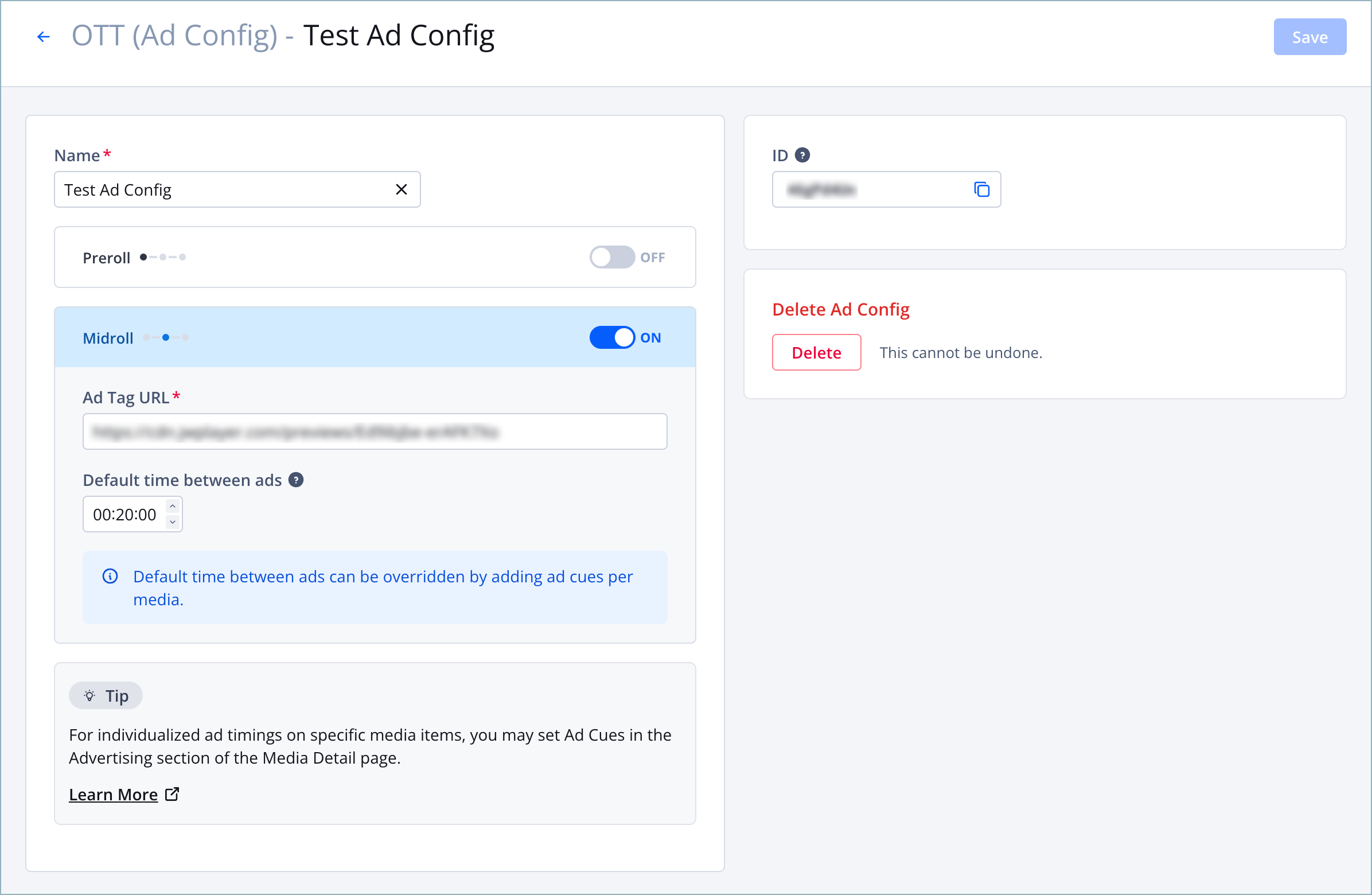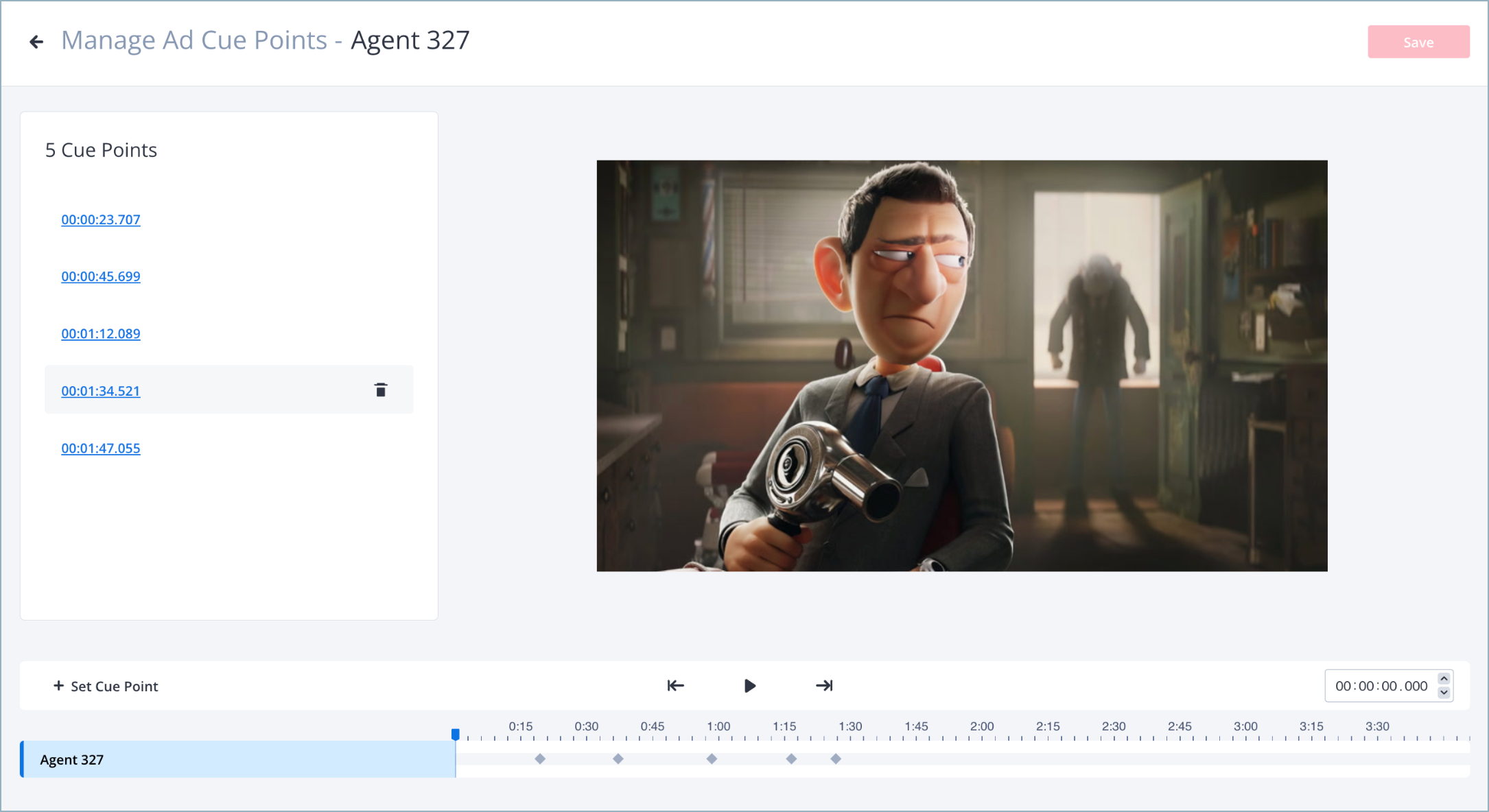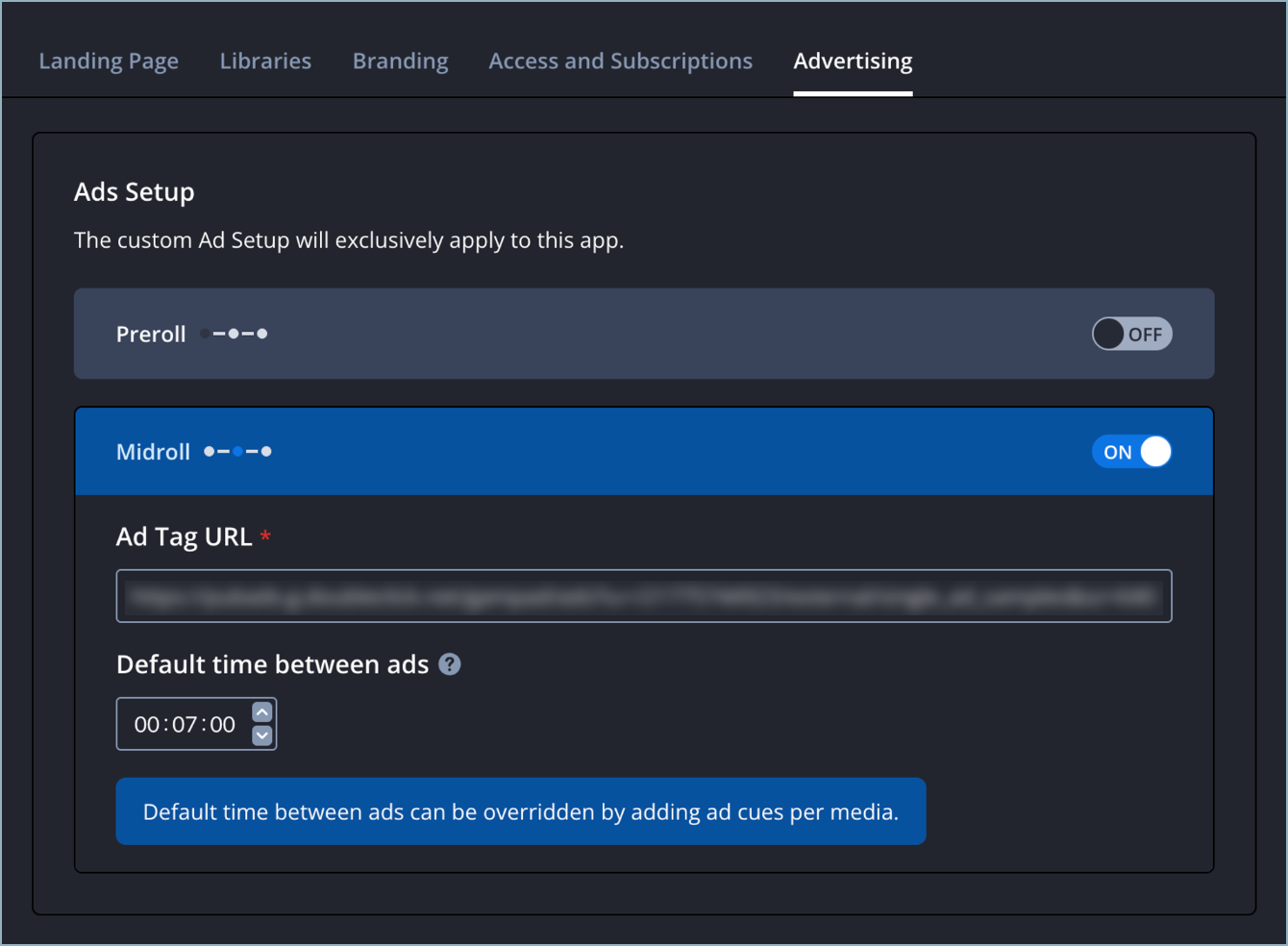Monetize apps with ads
Learn how to configure ads for your apps
This is a beta offering.
By using this documentation, you are agreeing to abide by the terms of the JWP Beta Program Agreement.
Apps support monetization by inserting video ads across all supported platforms. The following table lists the best advertising method to use with a type of content.
| Content | Advertising Method |
|---|---|
| Videos On-Demand (VOD) • Movies • Series | Client-side ad insertion |
| Live Streams • Live Events • 24/7 | Server-side ad insertion |
Prerequisites
| Item | Description |
|---|---|
| Beta entitlement | Ad cues require a beta entitlement to appear in the JWP Dashboard. To receive entitlement, please contact your JWP representative. |
| App compatibility | Your app must be compatible with media-level ad cues to use this feature. Please verify with your app developer if your platform supports JWP ad cues. |
Configure client-side ad insertion
For on-demand videos, you can configure and manage ad cues. Ad cues address app-specific needs, where conventional ad scheduling methods are ineffective.
By utilizing ad cues, broadcasters can schedule ads to appear at preset intervals in app content, ensuring effective advertising throughout media:
- Allowing precise ad placement
- Creating a consistent ad display experience
- Supporting diverse ad formats
- Enhancing user experience
- Simplifying ad integration
- Improving in-app ad performance tracking
Ad cues are not compatible with ad schedules. They must be associate with an ad config.
Additionally, apps only support client-side ad insertion through the IAB VAST and VMAP standards.
Enable in-app advertising

Example ad config
Follow these steps to configure advertising in your app:
Set up an ad config
Follow these steps to set up your ad config:
-
From the Advertising page, on the OTT (Ad Config) tab, click Create Ad Config. The ad config settings appear.
-
Enter an alphanumeric Name for the ad config.
-
Toggle your desired ad format to ON.
You must select at least one ad format for ads to appear in your content.
Option Description Preroll Plays ads at the beginning of the media: - Toggle the Preroll tab to ON.
Midroll Interrupts content to play ads: - Toggle the Midroll tab to ON.
-
Under Ad Tag URL, enter an ad tag to run for the advertisements.
-
(For Midroll only) Under Default time between ads, enter an interval (in hh:mm:ss) to serve as the time elapsed between ad cues.
If you leave this field empty, the time defaults to 10 minutes (00:10:00).
-
Click Save.
-
(Optional) Add media-level ad cues to your content.
Associate an ad config with an app
Follow these steps to connect an ad config with your app in order to begin advertising:
-
From the Apps page, select an app config. The app config settings appear.
-
Under the Advertising tab, click the OTT (Ad Config) radio button. The OTT (Ad Config) dropdown menu appears.
-
From the dropdown menu, select an ad config to associate with the app.
-
Click Save.
-
(Optional) Click Preview. A new browser tab opens displaying an interactive preview of the app.
If you plan to preview your ad setup, consider setting up ad cues with test ads.
Add media-level ad cues
You can set cue points to control when ads are shown on a media item. Media-level ad cues will override your app cue settings. If you do not configure media-level ad cues, the advertisements will follow your app-level cues
Media-level ad cues are not compatible with the Other media type. Other refers to content that does not contain an embedded video, such as series, hubs, or static pages.
For client-side ad insertion in apps, we suggest migrating from ad schedules to ad cues.

Manage Ad Cue Points editor
Follow these steps to add media-level ad cues for broadcasting content:
- From the Media Library, select a media item. The media details page appears.
- Below the preview player, on the Advertising tab, click Manage. The Manage Ad Cue Points editor appears.
- Click + Set Cue Point. The timestamp selector appears in the Cue Points sidebar.
- Enter a timestamp into the selector (in hh:mm:ss.sss format). The ad cue will appear as a marker along the media’s timeline.
The value of the timestamp must not exceed the total length of the media item.
- Click Save.
- (Optional) Repeat steps 3-5 to create another ad cue.
Migrate from ad schedules to ad cues
Migrating from ad schedules to media-level ad cues is a strategic move for broadcasters looking to optimize in-app advertising.
Most ad schedule settings are not applicable for broadcasters in app environments. Ad cues enable you to schedule ads at preset intervals in a media item, ensuring effective advertising throughout your content.
Before migrating, ensure that your app can support ad cues, as rendering the ad involves a new endpoint.
Follow these steps to migrate to ad cues:
- From the Advertising page, select an ad schedule. The ad schedule settings appear.
- Copy the Ad Tag URL from your Preroll or Midroll ad break.
- Enable in-app advertising (steps 1-4).
- Under Ad Tag URL, paste the ad tag for your Preroll or Midroll ad break.
- Beside the Preroll or Midroll tile, click the trash icon to remove the ad schedule from the advertisement.
Ad schedules will appear in the app config for the user to remove only when setting up media-level ad cues.
- (For Midroll only) Under Default time between ads, enter an interval (in hh:mm:ss) to serve as the time elapsed between ad cues.
If you leave this field empty, the time defaults to 10:00 minutes (00:10:00).
- Click Save.
- (Optional) Click Preview. A new browser tab opens displaying an interactive preview of the app.
If you plan to preview your ad set up, we recommend setting up an ad cues with test ads.
Configure server-side ad insertion
For live events, apps support server-side ad insertion (SSAI) through the Apple HLS standard. You can trigger ad breaks by sending SCTE-35 tags with your live stream ingest.
For more information, learn how to monetize a live stream.
If you intend to serve SSAI ads in your apps, inform your JWP representative. Your JWP representative can help you configure this functionality for each Broadcast Live channel.
FAQ
What is an ad config?
The ad config houses the advertising settings in your app config. The ad config provides an easy way for broadcasters to set up advertising for an app:
- Ad tag URL (VAST format)
- Default timing to display ads every 10 minutes
- Media-level ad cues
The ad config also serves as an easy way for partners to consume advertising:
- VMAP support for external players
- Server-side calculation of ad timings for specific media

Ad config view
Updated 23 days ago


